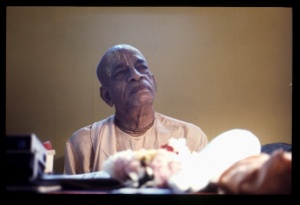CC Madhya 20.187: Difference between revisions
m (1 revision(s)) |
No edit summary |
||
| Line 1: | Line 1: | ||
{{ | [[Category:Sri Caitanya-caritamrta - Madhya-lila Chapter 20|C187]] | ||
<div style="float:left">'''[[Sri Caitanya-caritamrta|Śrī Caitanya-caritāmṛta]] - [[CC Madhya|Madhya-līlā]] - [[CC Madhya 20|Chapter 20: Lord Śrī Caitanya Mahāprabhu Instructs Sanātana Gosvāmī in the Science of the Absolute Truth]]'''</div> | |||
<div style="float:right">[[File:Go-previous.png|link=CC Madhya 20.186|Madhya-līlā 20.186]] '''[[CC Madhya 20.186|Madhya-līlā 20.186]] - [[CC Madhya 20.188|Madhya-līlā 20.188]]''' [[File:Go-next.png|link=CC Madhya 20.188|Madhya-līlā 20.188]]</div> | |||
{{CompareVersions|CC|Madhya 20.187|CC 1975|CC 1996}} | |||
{{RandomImage}} | |||
==== TEXT 187 ==== | ==== TEXT 187 ==== | ||
<div | <div class="verse"> | ||
vraje gopa-bhāva rāmera, pure kṣatriya-bhāvana | :vraje gopa-bhāva rāmera, pure kṣatriya-bhāvana | ||
varṇa-veśa-bheda, tāte ‘vilāsa’ tāṅra nāma | :varṇa-veśa-bheda, tāte ‘vilāsa’ tāṅra nāma | ||
</div> | </div> | ||
| Line 12: | Line 16: | ||
==== SYNONYMS ==== | ==== SYNONYMS ==== | ||
<div | <div class="synonyms"> | ||
''vraje''—in Vṛndāvana; ''gopa-bhāva''—emotion of a cowherd boy; ''rāmera''—of Balarāma; ''pure''—in Dvārakā; ''kṣatriya-bhāvana''—the emotion of a ''kṣatriya''; ''varṇa-veśa-bheda''—by differences of dress and color; ''tāte''—therefore; ''vilāsa''—pastime expansion; ''tāṅra nāma''—His name. | |||
</div> | </div> | ||
| Line 19: | Line 23: | ||
==== TRANSLATION ==== | ==== TRANSLATION ==== | ||
<div | <div class="translation"> | ||
“Balarāma, who has the same original form as Kṛṣṇa, is Himself a cowherd boy in Vṛndāvana, and He also considers Himself a member of the kṣatriya race in Dvārakā. Thus His color and dress are different, and He is called a pastime form of Kṛṣṇa. | “Balarāma, who has the same original form as Kṛṣṇa, is Himself a cowherd boy in Vṛndāvana, and He also considers Himself a member of the kṣatriya race in Dvārakā. Thus His color and dress are different, and He is called a pastime form of Kṛṣṇa. | ||
</div> | </div> | ||
__NOTOC__ | |||
<div style="float:right; clear:both;">[[File:Go-previous.png|link=CC Madhya 20.186|Madhya-līlā 20.186]] '''[[CC Madhya 20.186|Madhya-līlā 20.186]] - [[CC Madhya 20.188|Madhya-līlā 20.188]]''' [[File:Go-next.png|link=CC Madhya 20.188|Madhya-līlā 20.188]]</div> | |||
__NOTOC__ | |||
__NOEDITSECTION__ | |||
Revision as of 03:57, 7 September 2021
Śrī Caitanya-caritāmṛta - Madhya-līlā - Chapter 20: Lord Śrī Caitanya Mahāprabhu Instructs Sanātana Gosvāmī in the Science of the Absolute Truth

His Divine Grace
A.C. Bhaktivedanta Swami Prabhupada
A.C. Bhaktivedanta Swami Prabhupada
TEXT 187
- vraje gopa-bhāva rāmera, pure kṣatriya-bhāvana
- varṇa-veśa-bheda, tāte ‘vilāsa’ tāṅra nāma
SYNONYMS
vraje—in Vṛndāvana; gopa-bhāva—emotion of a cowherd boy; rāmera—of Balarāma; pure—in Dvārakā; kṣatriya-bhāvana—the emotion of a kṣatriya; varṇa-veśa-bheda—by differences of dress and color; tāte—therefore; vilāsa—pastime expansion; tāṅra nāma—His name.
TRANSLATION
“Balarāma, who has the same original form as Kṛṣṇa, is Himself a cowherd boy in Vṛndāvana, and He also considers Himself a member of the kṣatriya race in Dvārakā. Thus His color and dress are different, and He is called a pastime form of Kṛṣṇa.